Coya – the Peruvian trend takes off in Dubai (at a price)
 Peruvian food is currently having a bit of a moment. British supermarkets have started stocking ceviche [seh-vee-chey] on their shelves alongside sushi, two Lima venues top the 2014 list of the 50 best Latin American restaurants, 2014 was ‘the year of Peruvian cuisine’ according to the Culinary Institute of America, and a rash of Peruvian restaurants has been opening internationally over the last two to three years. With the opening of Barcelona’s Pakta, even Catalonia’s legendary Adrià family has jumped on board the bandwagon (though note one big name chef disagrees). Given Peruvian food is a natural fusion of South American flavours with strong culinary influences from an important Japanese-Peruvian community, the appeal should be obvious – even if it took most of us (Nobu Matsuhisa excepted) until the 21st century to notice.
Peruvian food is currently having a bit of a moment. British supermarkets have started stocking ceviche [seh-vee-chey] on their shelves alongside sushi, two Lima venues top the 2014 list of the 50 best Latin American restaurants, 2014 was ‘the year of Peruvian cuisine’ according to the Culinary Institute of America, and a rash of Peruvian restaurants has been opening internationally over the last two to three years. With the opening of Barcelona’s Pakta, even Catalonia’s legendary Adrià family has jumped on board the bandwagon (though note one big name chef disagrees). Given Peruvian food is a natural fusion of South American flavours with strong culinary influences from an important Japanese-Peruvian community, the appeal should be obvious – even if it took most of us (Nobu Matsuhisa excepted) until the 21st century to notice.
Coya at the Four Seasons Resort on Jumeirah Beach Road is the Dubai branch of the one Michelin star London Peruvian restaurant that The Times declared to be one of the 20 coolest restaurants in Britain and Zagat described as one of the 10 hottest restaurants in the world. It’s not the first Peruvian restaurant in Dubai, but it might well be the most hotly anticipated. The London original offers high-end Peruvian food for the Mayfair in-crowd, for people who want to see and be seen. The Ferraris, Bentleys, and Rolls-Royces parked next to the Dubai branch’s (free) valet parking desk, the doormen by the sense-of-occasion entry, and the stylishly dressed clientele all suggest that our local version – packed by 8.30pm even on a Sunday night – is trying to fill the same niche as its London parent; perhaps even more so.
But is the food any good? Fortunately, the answer is yes – even if the menu is yet another “the food will come as it’s ready sharing concept”, the current bubonic plague of restaurant trends. The menu starts with ceviche (cubed fish cured in a citrus marinade known as leche de tigre, or ‘tiger’s milk) and tiraditos (more overtly Japanese-influenced raw sliced fish). I ordered the pargo a la trufa ceviche of red snapper, truffle, ponzu, and chives. It’s the most expensive ceviche at AED78, but the sharpness of the ponzu and the earthiness of the truffles were very well-balanced. The next dish to arrive was from the anticuchos (grilled skewers): an antichuco tradicional of beef heart, rocoto chilli pepper, and garlic. We had to convince the waitress that we really wanted the beef heart, so I suspect they’ve had some negative reaction to the dish – but we loved it. The meat was soft and tender but with some grilled external crispiness, and with a rich smoky flavour from the rocoto chilli sauce. An order of amarillo chilli tempura from the ‘para picar’ (small dish; literally ‘to nibble’) menu section was a mild disappointment. There was nothing wrong with the technically accomplished tempura batter or the yellow chilli sauce, sharp and with a nicely building chilli heat, but the chillies inside the tempura seemed comparatively bland.

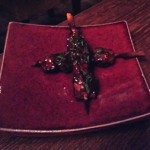
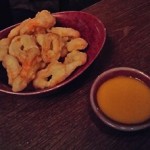
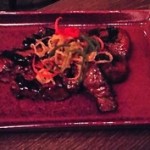
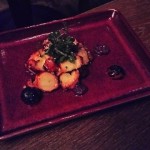

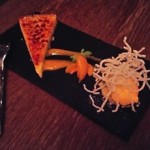

So far, so good. And then the mains arrived, along with the big off-note of the night. There was nothing wrong with the quality of the food, mind. My solomillo de res (spicy beef fillet, crispy shallot, and garlic) was an excellent dish, with hints of Japanese sweetness accompanying the well-seasoned and incredibly tender fillet. Mrs White Hat’s pulpo al olivo (octopus cooked in a josper oven with Peruvian olives) was also brilliantly cooked, with the olives and grilled cherry tomatoes offering a really good balance of flavours alongside the tender octopus. But the portion sizes…you pay AED190 for a few small slices of (admittedly excellent) unaccompanied beef fillet, and then have to spend at least another AED30 for sides. Now, our side dish of patatas bravas consisted of superb discs of well-sauced simultaneously crisp and soft potato – but the side was at least as big as, possibly larger than the mains which seem wildly overpriced given the portion sizes. If our portions were representative, then I can only imagine how someone ordering the wagyu sirloin might feel to find out they’ve spent more on their dish than what Wolfgang Puck’s Cut charges for a more generous serve of the same cut.
Given the stinginess of the mains, both of us had room for dessert. Mrs White Hat’s lime tart was a delight, essentially a lime crème caramel in tart form with an apricot sorbet that she’s still drooling over (“mmmmm, it was good”). My chicha morada was a combination of gently spiced granita and ice cream based on traditional Peruvian purple corn, accompanied by orange shortbread. It seemed a little underpowered in comparison to the lime tart, and perhaps would have worked better as a palate cleanser than as a full dessert.
Service was delightful, with two ordering problems dealt with professionally and smoothly by excellent waitresses. I had to remind our main waitress that I’d ordered a pisco sour (which eventually arrived from the bar halfway through my main), and an incorrect dessert was delivered. The fact that there were two problems with the order at a single table of two does raise an eyebrow given the prices that Coya charges. One error could happen to anyone, but two suggests some kitchen and bar communication issues are being worked out. The decor offers a spruced-up historic Latin American urban vibe, with a chic and modern combination of metallic finishings alongside wood and amber-coloured furnishings. But the air conditioning could probably be turned down a notch; it was so cold Mrs White Hat had to use a scarf as a wrap.
Coya does a lot of things brilliantly, but how you ultimately feel about the experience will probably depend on how you feel about the prices they charge. The prices for the smaller sharing plates are fair enough given the venue, with our choices ranging from AED40 (for the tempura chillies) through to AED78 (for the ceviche with truffles), but the prices charged for the mains – which head north of AED400 at the upper end of the menu – seem at best ambitious given the portion sizes. We ordered the least expensive main (the octopus at AED82) and still spent AED650 on dinner for two – excluding alcohol, but including an AED30 bottle of water. We were by no means full after a reasonably representative tour of the menu. Paradoxically – given alcohol prices in Dubai – the pisco sour costs less than it does in London (AED50 v. £11.95), but that moment of pricing sanity doesn’t really counterbalance the cost of those surprisingly small mains. If someone else is paying, if you own a Ferrari, or if you’re eating on an expense account, I suspect you’ll love Coya. Me, I just can’t helping feeling that you shouldn’t leave a restaurant resentful over what you’ve been charged for, or the size of, your main course. For all the undoubted positives, and there are many, it’s that smouldering resentment over those mains that brings my FooDiva rating down to three and a half knives, instead of four (out of five).
Have you tried Peruvian cuisine? What are your expectations regarding the size of a main course?
Hasta la proxima,
The Man in the White Hat.
So who’s FooDiva’s anon guest reviewer, The Man in the White Hat? He has an abiding interest in both history and food; his holidays tend to combine an intriguing local cuisine with a UNESCO World Heritage site, and he’s eaten his way across some 50 countries in Europe, Asia, Africa, North and South America, and Australasia. He currently lives in Dubai, where he edits a couple of academic publications.


























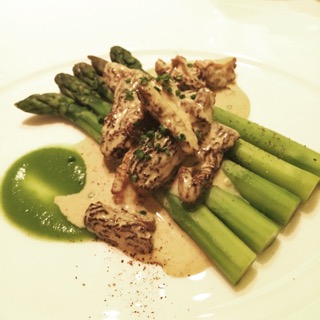
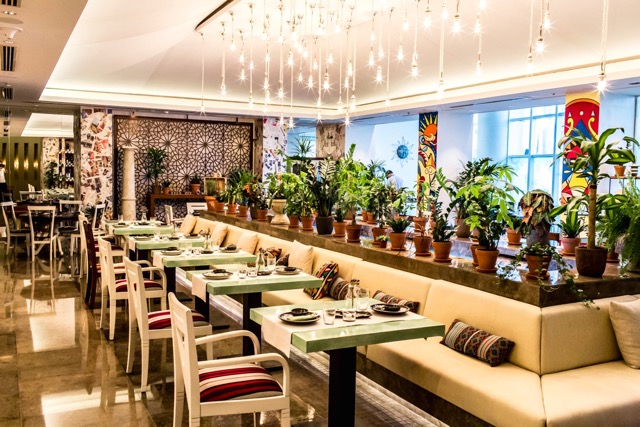
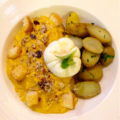



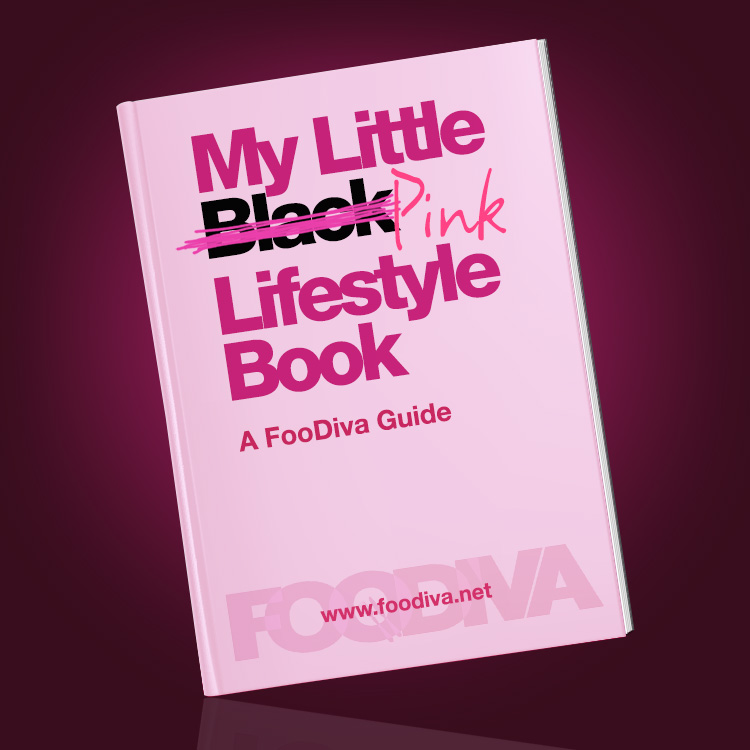






Great review, I have been hearing that all the outlets in this hotel are over-priced which doesn’t really surprise me if I am totally honest. How were the food prices comparable to the UK restaurant?
The prices seem only marginally higher for food than their London counterparts. You can download all of the London menus here: http://www.coyarestaurant.com/restaurant#menu1
The solomillo de res (the beef fillet main) costs £32 in London, which I work out to be just under AED 180 – only AED 10 less than charged in Dubai. And as I note in the review, a pisco sour costs less in Dubai than in London (which is a surprise given alcohol’s involved). So to be fair, they’re not using the likelihood that ingredients are more expensive in the UAE to charge prices that are unfairly high compared to their London counterpart.
The question is should the prices be that high to begin at either branch with given what’s on offer. Again, the starters/small plates seem reasonably fair, but the mains are more of an issue. The London branch of Coya is in Mayfair, so will likely charge accordingly. As Fay Maschler noted in her London Evening Standard review of the Mayfair branch (http://www.standard.co.uk/goingout/restaurants/fay-maschler-reviews-coya-8363652.html):
“Although we were urged to order beef fillet and Chilean sea bass, the £32 price for each acted as a deterrent and even without them the bill jumped energetically upwards emboldened by stiff prices for mineral water, wine by the glass, coffee and tea.”
The Dubai branch is charging comparable prices.
Coya knows what it’s doing – it wants to be high-end (and really rather well-made) Peruvian food for the chic moneyed in-crowd. Anyone who fits that description will likely love it. Those of us who drive up to the valet parking in a slightly battered 5 year old Corolla – rather than a Ferrari – might have qualms.
Thanks for the in depth reply. I normally find that the UK counterparts are cheaper than the outlets that rear their heads here. I saw someone post on FB that this hotel is charging 45 AED for a coffee from their coffee shop. I shall get my Corolla serviced lol
I don’t mind a “stingy” or small main dish if I’m the only one eating it and I get to enjoy every single bite. But if I’m expected to share it with others, then it’s a problem! I wonder if we can have a filling dinner at Coya by only ordering a good amount of starters and then going straight to desserts?
I think you could, SJ. A meal could be built out of the ceviche, tiraditos, anticuchos, and ‘para picar’ sections while still leaving room for dessert. In fact, I was having an e-mail conversation with FooDiva herself about this yesterday, and we both agreed that Coya could perhaps usefully break down the distinction between the various ‘small plates’ (not technically starters) and the ‘mains’. This isn’t how dishes are explicitly described in the written menu, and I’m only using the word ‘mains’ because that was the phrasing specifically used by our waitress when discussing the menu with us and taking our order. A couple of the dishes under what looks like the ‘mains’ section – notably the octopus and the chicken wings – actually cost less than many of the dishes presented as smaller sharing plates. Some rethinking of menu presentation could perhaps help to better manage customer expectations. As of right now, Coya’s menu is a bit like Frioul’s was when I reviewed the latter – a slightly confusing mix of on-trend sharing dishes and more traditional mains; and it’s not necessarily always 100% clear where the boundary lies.
Good review and agree with your observations. I just dined there a couple of days back and thought that the Pisco sours and the Chilean Sea bass were to die for (and were well priced). The shitake mushrooms hot pot at AED240 was shocked me when paying the bill (the dim lights and fading vision had made me read that as AED140!) – the waiter brought to my attention that this was the “wagyu stake for vegetarians”. Not sure that made us feel better. But generally was happy with the service and attention and of course the food quality and taste. Would go back there and next time and perhaps order more intelligently. Reducing thw four knives to three and half just for the price is fair 🙂
But I bet that shitake hot pot was likely delicious, even if you were paying AED 240 for the privilege of eating it…
I think you put your finger on a lot of issues here, AK. There’s nothing wrong with the _quality_ of the food, and in my experience the service is good. Several of the dishes are reasonably well-priced. And then suddenly you realise that you’re also paying AED 190 for a few slices of (admittedly excellent) beef, or AED 240 for a mushroom hot pot, and you think ‘hang on, how did _that_ happen?’
And perhaps it might well be possible to have a really fantastic night out at Coya that didn’t break the expense account by ‘ordering intelligently’; but the menu doesn’t necessarily make it clear how to do that, and do I necessarily want to spend my time second-guessing my order based on a sometimes slightly cryptic menu?
The shitake mushroom hot pot was actually delicious – if one could push them, am sure they could have made a rare or a medium-rare version going with the “wagyu steak” analogy the server gave. As an afterthought I wish I had not noticed the price …
I am not familiar with Peruvian cuisine but I find it unacceptable, especially when you pay high prices that the soup arrives after the main dish and a wrong dessert served. Kitchen obviously have some issues to solve.
Just for clarity, Kelly, the late-arriving pisco sour was a traditional Peruvian cocktail rather than a soup – so it was merely slightly disappointing to have it arrive late rather than a more problematic case of a starter soup arriving after a main.
But I think you otherwise have a point. The two order mistakes were handled very professionally by the friendly staff, but two mistakes at a table for two does raise an eyebrow when you’re paying the prices that Coya charge. Of course errors can happen to anyone, even at the best establishments; but that price point, you’d hope they’d be incredibly rare rather than twice in one night at one table. It’s a solvable problem, but if my experience was in any way typical they need to work on solving it ASAP given the market niche they’re trying to fill.
I’ve always taken exception to people calling a salad of fish slivers cured with citrus “Peruvian cuisine”. That would be like the Lebanese or the Afghans calling grilled meat “Lebanese cuisine” or “Afghan cuisine”. I mean it’s what you do with the stuff – it’s just common sense. The first and only time I ever had “ceviche” was at the Israeli Gaucho (woops – should that be Argentine, or perhaps both 😉 ). It was so mediocre that it couldn’t help but reinforce my preconceptions – curing fish with lemon, lime, or orange doesn’t belong to anyone and is by no means anything worth forking large sums of money over unless it’s exceptionally well executed, which in Gaucho’s case , it wasn’t. I would have liked to know what the various other desserts tasted like – the words salted caramel which I saw on one Instagram account some several weeks ago was all I needed to hear to make me want to go to Coya (of course, I make the sweet stuff at home every week, but let’s not go there!!!). I just can’t help but feel that Peruvian cuisine or at least its fine dining iteration is taking a cue from French and Japanese cuisines in an attempt to elevate itself to haute cuisine status so as to justify the soaring prices that you criticize in your review. Plonk your venue in Mayfair or at The Four Seasons, douse your fish with a bit of lime and charge the glitterati through the roof for Peruvian fine dining. For that alone, you should give them five-and-a-half stars, Mr White Hat 😉 !!!
There are, of course, a range of cuisines that cure fish in some form of citrus marinade. It’s a common enough practice in Southeast Asia, after all. Peruvian ceviche is, however, a dish that’s genuinely traditional to Peru, and with a long history dating back at least to the early colonial period (and with hints from archaeological evidence that it might even have roots in the 2000 year old Moche culture of pre-Columbian Peru).
The traditional version often saw the fish cure for several hours, while the modern version using a short curing time – developed in the 1970s, before Peruvian food went global – had strong influences from Peru’s Japanese community. This is an important immigrant community that’s even produced one Peruvian president (Alberto Fujimori), so this is a genuine fusion of local Pacific Rim cultural influences that only subsequently went global.
Which is a very long way of saying that ceviche is an entirely legitimate Peruvian culinary cultural tradition even recognising that other cultures have developed not dissimilar dishes (though no one seems to think spaghetti to be any less Italian just because East Asia’s in love with noodles).
That said, I think you’re right that there are any number of dismal versions of ‘ceviche’ served in restaurants that don’t have a clue, and are just trying to serve up a a trendy and easy to prepare dish of citrus-cured fish. But should we stop considering sushi and sashimi to be inherently Japanese just because of the wide variety of horrible sushi-like dishes served at any number of food outlets with only a tenuous connection to Japan?
Don’t misunderstand me; I agree that there’s likely a level of cynicism in how the Peruvian food trend – like any hip food trend – is being appropriated and manipulated by some sectors of the hospitality industry. But this shouldn’t allow us to lose sight of the fact that Peru does have a genuinely exciting and dynamic multicultural food culture, even if a so-called ceviche at Gaucho (or any of the other non-Peruvian Dubai restaurants serving a version of the dish) does its best to obscure that.
As to the high-end version of Peruvian cuisine, you may well have a point – but as you note with your French and Japanese examples, charging silly amounts of money for the haute cuisine version is hardly a sin unique to Peruvian food…
WOW! The way you answered that leaves very little room for me to manoeuvre – I was kind of hoping for a nice counter punch to the jaw (I only mean that in jest, naturally 😉 ) but it seems your mouth is quite the treasure – we need more informed reviewers like you Mr White Hat (I do very much enjoy the little tid bits of history that accompany your write-ups). It’s just a shame that a dish with such history behind it never manages to live up to the hype – I said that I only had ceviche at Gaucho, but I now remember also having it at Tony Starck at The Dubai Mall and it was, again, very yawn inducing – a real bore. Perhaps, my experience at Coya shall change my perceptions of this dish, especially at those lofty prices. In any case, nice work, and I look forward to your future reviews 🙂 .
……Tiraditos, para picar……leche de tigre and antichuco………antichuco? What the ^&%$ are these insults or dishes???!?? and an amarillo to boot!
Chicha morada? How very rude!
I suppose you need quite a few Pisco Sour just to understand the *&&*%^…Menu.
Oh Man…..We gonna need a bigger dictionary…..probably load it on an Ipad as it will not fit on a Iphone 😉
I had trouble pronouncing the name of these dishes, nevermind eating them…..probably plastered over the walls….after the now infamous Pisco Sour…..Yo bruv, egg white organic? I am curious to know what happens to the yolks? …….Barshelonna….Baaaarsheelonaaaaaa.
I can either pay for Salik or Coya…..can’t do both!
Why is it that people have to go long and far and break the bank for a morsel or two?
Why stop at Peruvian food. I am looking forward for the arrival of a Kiribati restaurant to enjoy a good Palu Sami (at least an easy dish name).
You see, I am a fast learner.
Taxiiiiiiiiiiiii
Quizás el problema es que no habla español, señor Jayeim 😉
My Spanish stopped at Speedy Gonzales famous war cry:
Ándale, andale!……Arriba, arriba!…..Epa Epa Epa! 😉
Do I win anything?